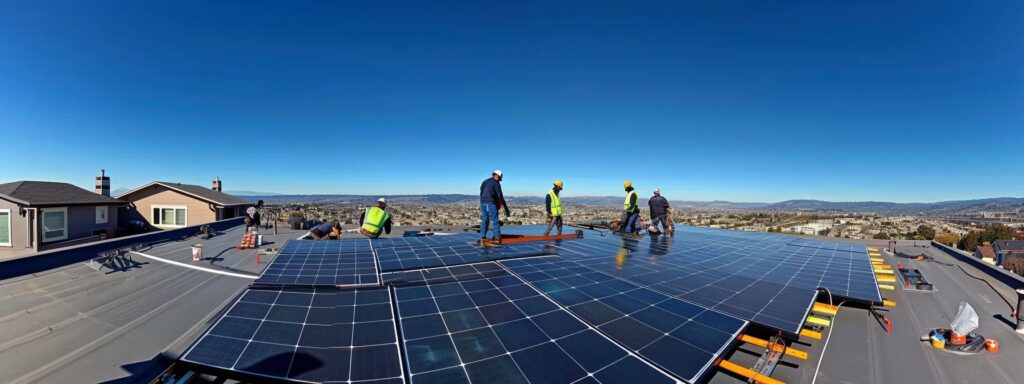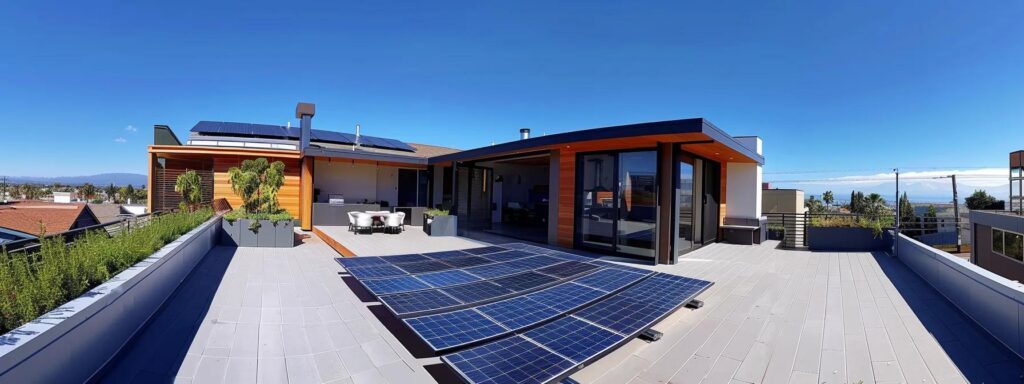Step-by-Step Solar Panel Installation Guide for Homeowners
Thinking about installing solar panels in your home? Recent studies show that households with solar power can save 50% or more on their electricity bills. This guide covers essential considerations before installation, detailed steps for the process, and post-installation tips to maximize efficiency. By following these instructions, homeowners can confidently navigate their solar panel project, ensuring they select the right system, whether through Sunfinity Power leasing or purchasing options. Addressing potential stressors can lead to a smoother installation experience, ultimately providing long-term savings and energy independence.
Key Takeaways
- Assessing energy needs is essential before installing solar panels for optimal system sizing
- Evaluating the roof’s condition ensures maximum solar exposure and structural integrity for the installation
- Financial incentives and grants can significantly reduce the costs associated with solar panel installation
- Understanding local regulations is crucial to ensure compliance and safety during the installation process
- Selecting a reliable installer minimizes risks and promotes efficient system performance post-installation

Assessing energy needs is the first step for homeowners considering sunfinity power solar panel installation. Evaluating the roof’s condition and orientation is essential to ensure optimal solar exposure for the array. It is vital to investigate financial incentives and grants available in the area. Additionally, reviewing local energy regulations and building codes will promote safety by adhering to standards, especially concerning the junction box installation. Finally, researching and selecting a reliable installer will prevent future issues such as short circuits and ensure that the installation process, including marking with a chalk line, is executed efficiently.
Assess Your Energy Needs
Assessing energy needs is foundational for homeowners contemplating Sunfinity Power solar panel installation. A thorough inspection of current energy consumption will identify usage patterns and peak demand times, which informs the sizing of the solar array. This process not only helps in selecting the right system capacity but also minimizes potential risks related to underperformance, ensuring compliance with the national electrical code, particularly when evaluating wiring requirements for optimal sine wave production:
| Energy Needs Assessment Steps | Description |
|---|---|
| Step 1: Analyze Utility Bills | Review past utility bills to identify average monthly energy usage. |
| Step 2: Conduct Home Energy Audit | Inspect appliances and systems to determine energy consumption. |
| Step 3: Identify Peak Usage Times | Note when energy consumption is highest to plan solar generation accordingly. |
| Step 4: Evaluate Future Needs | Consider any planned changes that may increase energy needs, such as new appliances. |
Evaluate Your Roof's Condition and Orientation
Evaluating the roof’s condition and orientation is a critical step prior to solar panel installation. A sturdy, well-maintained roof ensures that the structure can support the weight of the solar array while optimizing exposure to sunlight for maximum renewable energy production. Homeowners should assess potential shading from trees or nearby buildings, as well as the roof’s angle, which influences energy capture; certain orientations yield better efficiency. Inspecting the roof for any signs of damage or aging will help inform decisions regarding necessary repairs before integrating the electrical wiring and circuit breaker system, ensuring a safe and effective installation process.
Investigate Financial Incentives and Grants
Investigating financial incentives and grants available for solar panel installation can significantly reduce initial costs for homeowners. Various programs may offer rebates based on energy production efficiency and ampere ratings, potentially offsetting expenses caused by high voltage systems. Furthermore, understanding these incentives can guide decision-making regarding the angle and placement of solar panels to minimize shading and maximize energy capture, ultimately leading to more effective energy management.
Review Local Energy Regulations and Building Codes
Reviewing local energy regulations and building codes is essential for a successful solar panel installation. Homeowners must ensure compliance with regulations concerning electric current requirements and proper installation techniques, such as securing pipes and conduits. Additionally, understanding the guidelines for drilling into structures can help avoid damage and ensure the safety of the installation, providing peace of mind regarding backup power availability should the system need adjustments or repairs.
Research and Select a Reliable Installer
Researching and selecting a reliable installer is essential for achieving a solid return on investment when installing solar panels. Homeowners should look for certified professionals who have extensive experience with the specific configurations of power inverters and charge controllers. Asking for references and examining reviews can help identify installers who ensure that the system operates efficiently, providing adequate power output measured in volts while accommodating any future needs, such as electric vehicle charging integration. By choosing a trustworthy installer, homeowners can avoid potential pitfalls and enhance the overall performance of their solar energy system.
Having understood the key considerations, the next step awaits. Here, the reader will find the detailed path to setting up solar panels with clear guidance.
Detailed Steps for Solar Panel Installation

The process of installing a photovoltaic system involves several critical steps to ensure optimal performance and compliance. Initially, conducting a preliminary site evaluation is essential to assess the suitability of the location. This is followed by obtaining necessary permits and approvals from local authorities. Homeowners should then purchase quality solar panels, inverters, and other components, ensuring compatibility with their wattage needs. Executing the installation on-site requires careful attention, including following safety procedures and properly anchoring components. Finally, connecting the system to the electrical grid and passing inspection will confirm its readiness for sustainable energy production.
Conduct a Preliminary Site Evaluation
Conducting a preliminary site evaluation is a fundamental step in the solar panel installation process, as it helps to determine the suitability of a location for solar energy production. Homeowners should assess factors such as roof angle, shading from trees or buildings, and overall access to sunlight throughout the year. Additionally, analyzing the existing electrical load is necessary to ensure the system can adequately meet energy demands and potentially qualify for a rebate or net metering, enhancing financial returns on the investment. Professional installers can offer insights into ventilation requirements to protect the performance of the solar panels and equipment. The following steps should be taken during this evaluation:
- Check the roof’s orientation and angle for optimal sunlight exposure.
- Evaluate surrounding structures and vegetation for shading effects.
- Analyze the current electrical load to match the system capacity.
- Consider local weather patterns and environmental factors.
- Consult with a professional for technical guidance on installation requirements.
Obtain Necessary Permits and Approvals
Obtaining necessary permits and approvals is a critical step in the solar panel installation process, as it ensures compliance with local regulations. Homeowners should start by checking their specific zip code to identify applicable incentive programs and guidelines enforced by local authorities. This may involve submitting detailed diagrams of the planned installation, including specifications for electrical components like the inverter and diode connections, which must align with approved electrical standards to facilitate a safe and efficient setup.
Purchase Solar Panels, Inverters, and Other Components
When purchasing solar panels, inverters, and other components, homeowners should consider their energy consumption needs to select appropriate equipment. A well-designed system utilizes maximum power point tracking technology to optimize energy production, while understanding the wiring diagram is crucial for effective installation. It is essential to evaluate the complexity of the components and ensure compatibility, as this will facilitate seamless integration and improve overall efficiency, ultimately leading to enhanced performance of the solar energy system.
Execute the Installation Process on Site
Executing the installation process on-site is a critical stage in ensuring that solar panels perform efficiently. Proper flashing techniques must be applied to prevent water intrusion, which could damage both the array and the roof. Additionally, installers should connect the system to the electrical grid carefully to facilitate seamless energy transfer and utility access, while also considering optimizing the orientation for maximum sunlight exposure. Homeowners can benefit from understanding how to leverage available credits for energy generated, further enhancing the financial returns on their investment.
Ensure Safety Procedures Are Followed During Installation
Ensuring safety procedures are followed during solar panel installation is paramount for protecting both workers and the home. When using a ladder to access a flat roof, it is critical to follow ladder safety guidelines to prevent falls, which can lead to serious injuries. Additionally, when working with energy storage systems, homeowners must handle any batteries containing acid with care, adhering to local regulations to ensure proper disposal and minimize environmental impact, thus optimizing the overall efficiency of the system while safeguarding health and safety.
Connect to the Electrical Grid and Pass Inspection
Connecting the solar panel system to the electrical grid is a critical phase, as it enables homeowners to utilize energy generated by solar cells and potentially feed excess power back to the grid, offering financial benefits such as net metering. During this process, an inspector will verify that all components meet local codes and safety standards, ensuring that the connections do not pose a risk of failure or hazards. Properly anchoring equipment to rafters and following integration protocols helps ensure system reliability, contributing to successful participation in community solar programs when available:
| Step | Description |
|---|---|
| Step 1: Install Grid Connection | Securely connect the solar panel system to the electrical grid, ensuring all wiring is compliant with safety standards. |
| Step 2: Schedule Inspection | Arrange for an inspection through local authorities to evaluate the installation’s adherence to building codes. |
| Step 3: Adjust System Based on Feedback | Make any necessary adjustments based on inspection results to ensure operational efficiency and safety. |
| Step 4: Activate System | Once approved, activate the system to begin utilizing solar energy and contribute to grid management. |
Now that the installation process is clear, many questions remain. Understanding the common concerns about home solar systems will help as you consider this important step.
FAQs About Home Solar Panel Installation

Solar Panel Installation in MA & RI
This section addresses common questions related to solar panel installation for homeowners. Key topics include the advantages of solar power, time requirements for completing installations, cost factors—including materials like copper and clamps—and potential risks during the process. Additionally, homeowners will learn about maintenance practices that ensure optimal performance and voltage efficiency of their solar cells.
What Are the Benefits of Solar Energy for Homeowners?
Homeowners can experience significant benefits from installing solar energy systems. These systems typically utilize a solar inverter to convert direct current produced by solar panels into alternating current suitable for home use, allowing for energy independence. Additionally, integrating solar technology can greatly reduce utility costs over time by offsetting energy consumption measured by the electric meter and may even increase property value—making it a compelling choice for those considering construction projects or upgrades to their homes.
How Much Time Is Needed for a Complete Installation?
The duration for a complete solar panel installation can vary significantly based on several factors. Generally, homeowners should anticipate a timeframe of one to three days for the physical installation after materials such as concrete blocks and lithium batteries are prepared and delivered. However, potential delays may arise due to necessary permits, inspections, or specific tax credit applications that require approval, which can extend the overall timeline. Engaging with a qualified installer can provide clarity and a more accurate estimate based on individual circumstances.
What Factors Influence the Cost of Solar Panel Installation?
The cost of solar panel installation is influenced by several key factors, including the size of the system, the type of solar panels selected, and the complexity of the installation. Larger systems designed to meet higher energy needs typically incur greater costs, while premium solar panels may offer improved efficiency but at a higher price point. Additionally, installation difficulties due to roof height, angle, or orientation can increase labor costs, making it essential for homeowners to obtain detailed quotes from multiple providers to ensure an informed decision that aligns with their budgetary constraints.
Are There Risks Involved in the Installation Process?
There are inherent risks involved in the solar panel installation process that homeowners should be aware of. These risks can include safety hazards from working at heights, potential electrical shocks during the installation of solar systems, and structural damage to the roof if not executed correctly. By hiring qualified professionals who adhere to industry safety standards, homeowners can mitigate these risks and ensure a safe and successful installation process.
- Understanding safety hazards associated with working on roofs.
- Recognizing potential electrical risks when connecting solar systems.
- Ensuring proper execution to avoid structural damage to roofs.
How Can Homeowners Maintain Their Solar Panels?
Homeowners can maintain their solar panels effectively by adhering to a simple routine. Regularly inspecting the panels for dirt, debris, and obstructions ensures optimal sunlight exposure, thereby enhancing energy production. Additionally, scheduling professional cleanings and inspections at least once a year allows for early identification of potential issues, ensuring that the system operates efficiently and reaches its maximum lifespan.
With solar panels in place, the real journey begins. Understanding how to keep them working at their best will bring greater rewards.
Post-Installation Steps to Maximize Solar Efficiency

Maximizing Solar Efficiency
Homeowners can enhance the performance of their solar energy systems by implementing several key practices. Setting up an energy monitoring system allows for tracking production and consumption patterns. Gradually optimizing energy use with solar power maximizes benefits. Regular maintenance and cleaning of panels ensure peak efficiency. Understanding energy production and savings provides financial insights, while troubleshooting common issues helps maintain system reliability.
Set Up an Energy Monitoring System
Setting up an energy monitoring system is essential for homeowners looking to optimize the efficiency of their solar panel installation. This system enables tracking of energy production and consumption in real time, allowing for informed decisions on energy use patterns. By analyzing this data, homeowners can identify peak usage times and adjust their energy consumption accordingly, leading to cost savings and improved performance of their solar energy systems:
| Energy Monitoring Benefits | Description |
|---|---|
| Real-Time Tracking | Monitor solar production and household consumption as it happens. |
| Data Analysis | Identify trends and peak usage times for better energy management. |
| Performance Alerts | Receive notifications of any performance issues or drops in energy production. |
| Cost Savings | Make adjustments to energy use based on real-time data to lower utility bills. |
Gradually Optimize Energy Consumption With Solar Power
Gradually optimizing energy consumption with solar power allows homeowners to fully benefit from their solar panel systems. By consciously adjusting energy usage habits—such as running high-energy appliances during daylight hours—homeowners can enhance the advantages of solar production. This proactive approach not only maximizes energy savings but also contributes to a reduced carbon footprint, making a significant impact on sustainable living.
| Energy Optimization Strategies | Description |
|---|---|
| Time-of-Use Scheduling | Use energy-intensive appliances during peak solar production hours. |
| Energy-Efficient Appliances | Replace old appliances with energy-efficient models to lower overall consumption. |
| Smart Home Systems | Implement smart home technology to monitor and control energy use effectively. |
| Regular Maintenance | Schedule routine inspections and cleaning to ensure optimal system performance. |
Schedule Regular Panel Maintenance and Cleaning
Scheduling regular panel maintenance and cleaning is essential for maintaining the efficiency and longevity of a solar energy system. Over time, dirt, dust, and debris can accumulate on solar panels, obstructing sunlight and hindering energy production. Homeowners should plan for periodic inspections and cleanings, ideally once or twice a year, to ensure optimal performance and identify any potential issues before they escalate, securing a reliable and cost-effective energy solution.
Understand Your Energy Production and Savings
Understanding energy production and savings is vital for homeowners who have recently installed solar panels. By regularly reviewing energy output data, homeowners can see how much electricity their system generates and how it correlates with their consumption, allowing for informed adjustments in usage patterns. This analysis not only illustrates potential savings on utility bills but also highlights the overall efficiency of the solar energy system, empowering homeowners to maximize their investment and further reduce reliance on conventional energy sources.
Troubleshoot Common Issues After Installation
Troubleshooting common issues after the installation of solar panels is essential for optimal performance and longevity. Homeowners may encounter challenges such as decreased energy output, unexpected spikes in utility bills, or system alerts indicating faults. Identifying these problems early and consulting with a qualified technician can prevent further complications, ensuring the solar system continues to operate efficiently and meets the homeowner’s energy needs.
- Monitor energy production regularly to identify discrepancies.
- Check for shading issues caused by nearby trees or buildings.
- Inspect connections and wiring for potential signs of wear.
- Ensure cleanliness of solar panels to maximize sunlight exposure.
- Consult a professional installer for technical support if faults are detected.
To ensure your solar system works best, it’s time to consider which panels fit your home. The right choice will make a difference, and soon you will see how great solar energy can be.
Finding the Right Solar Panel System for Your Home

Homeowners must consider several key factors when identifying the right solar panel system for their property. First, comparing different types of solar panels ensures the selection of the most suitable option based on efficiency and cost. Evaluating inverter choices supports optimal energy conversion, while understanding battery storage solutions enhances energy security. Additionally, considering the best solar mounting methods maximizes installation effectiveness, and analyzing warranties provides long-term support assurance. Each of these aspects contributes significantly to making an informed decision about solar energy investments.
Compare Different Types of Solar Panels
When selecting solar panels, homeowners should compare the different types available, including monocrystalline, polycrystalline, and thin-film panels. Monocrystalline panels offer high efficiency and take up less space, making them ideal for homes with limited roof area. Conversely, polycrystalline panels are typically more affordable but may require more space due to their slightly lower efficiency. Thin-film panels provide flexibility and lower weight but tend to be less efficient overall. Understanding these options allows homeowners to make informed decisions that align with their energy needs and budget:
| Type of Solar Panel | Efficiency | Cost | Best For |
|---|---|---|---|
| Monocrystalline | 15-22% | Higher | Limited roof space |
| Polycrystalline | 13-16% | Lower | Budget-focused projects |
| Thin-film | 10-12% | Varies | Flexible mounting solutions |
Evaluate Inverter Options for Efficiency
When evaluating inverter options for solar panel systems, efficiency plays a pivotal role in maximizing energy output. Homeowners should consider inverters that employ maximum power point tracking (MPPT) technology, as these devices optimize the performance of solar panels by adjusting their operational point according to varying sunlight conditions. Selecting high-efficiency inverters not only enhances overall system performance but may also reduce electricity costs over time, allowing for greater savings on energy bills:
| Type of Inverter | Efficiency Rate | Best Use Case |
|---|---|---|
| String Inverter | 95-98% | Residential applications with minimal shade |
| Microinverter | 95-99% | Shade-prone areas or complex roof designs |
| Power Optimizer | 95-98% | Combines benefits of string and microinverters |
Understand Battery Storage Solutions
Understanding battery storage solutions is essential for homeowners looking to enhance their solar energy systems. Battery storage enables users to store excess energy generated during sunny days for use during cloudy periods or at night, thus increasing energy independence and reliability. By choosing the right battery system, homeowners can optimize their energy usage, manage electricity costs, and provide backup power during outages, making it a valuable addition to any solar setup.
Consider the Best Solar Mounting Methods
Choosing the best solar mounting methods is essential for maximizing the efficiency and durability of solar panel systems. Roof-mounted systems typically utilize fixed racking options, ensuring that panels are securely attached while optimizing sunlight exposure. For properties with ample land, ground-mounted systems offer flexibility in orientation and adjustment, allowing homeowners to easily modify tilt angles to capture the sun’s energy throughout the day.
Analyze Warranties and Long-Term Support Options
Analyzing warranties and long-term support options is vital for homeowners when choosing a solar panel system. A comprehensive warranty typically covers panel performance, equipment failure, and installation quality, providing peace of mind and financial security. Homeowners should seek warranties that extend at least 25 years for the panels and consider packages that include maintenance and repairs, ensuring reliable energy production and addressing potential issues without significant costs.
- Research available warranties for solar panels and inverters.
- Compare coverage between different manufacturers and installers.
- Look for long-term support options, including maintenance and monitoring services.
Choosing the right solar panel system is just the beginning. Next, understanding the estimated costs of installation will help clarify your path forward.
Estimated Costs of Solar Panel Installation

Understanding the estimated costs of solar panel installation is fundamental for homeowners evaluating this energy solution. This section breaks down installation costs, highlights potential savings and return on investment, and compares financing options available. It also explores tax credits and other financial incentives while calculating the possible increase in home value post-installation. Each of these factors plays a crucial role in making informed decisions about solar energy investments.
Breakdown of Installation Costs
The breakdown of installation costs for solar panels typically includes several key components that homeowners should consider closely. Initial expenses often encompass the purchase of solar panels, inverters, and mounting equipment, which can vary based on the type and efficiency of the chosen panels. Labor costs for professional installation also play a significant role, as experienced technicians will ensure that all systems comply with local codes and function optimally, ultimately leading to enhanced energy production and savings over time.
Determine Potential Savings and Return on Investment
Determining potential savings and return on investment is crucial for homeowners contemplating solar panel installation. By evaluating current energy costs and estimating future savings linked to solar energy generation, homeowners can assess how long it will take to recoup their initial investment. In many cases, homeowners see a reduction in utility bills, leading to significant savings over the lifespan of the solar system, which typically exceeds 25 years:
| Cost Factors | Potential Savings |
|---|---|
| Initial Installation Costs | Varies based on system size and equipment quality |
| Monthly Utility Savings | Estimated 20-50% off electric bills |
| Tax Credits and Incentives | Federal and state programs can offset installation costs by up to 30% |
| Increased Home Value | Average increase of 4% in property value |
Compare Financing Options for Solar Panel Installation
Homeowners considering solar panel installation should explore various financing options that can make the investment more manageable. These can include cash purchases for immediate outright ownership, solar loans that allow homeowners to pay over time while still benefiting from energy savings, and leasing options, where homeowners pay a monthly fee to use the system without the upfront cost. Each option has different implications on ownership, savings potential, and tax benefits, making it essential for homeowners to carefully assess which financing method aligns with their financial situation and long-term goals:
| Financing Option | Description | Pros | Cons |
|---|---|---|---|
| Cash Purchase | Full payment upfront for system ownership. | Complete ownership, no monthly payments. | Higher initial cost. |
| Solar Loan | Financing to pay gradually over time. | Immediate benefits, maintain ownership. | Monthly payments with accrued interest. |
| Solar Lease | Pay a monthly fee to use the system. | No upfront costs, simpler budgeting. | Lack of ownership and potential tax benefits. |
Explore Tax Credits and Other Financial Incentives
Homeowners can significantly reduce the upfront costs of solar panel installation by exploring available tax credits and financial incentives. Federal programs, such as the Investment Tax Credit (ITC), allow homeowners to deduct a substantial percentage of solar installation costs from their federal taxes, facilitating a quicker return on investment. Additionally, many states and local utilities offer various rebates or performance-based incentives, enhancing overall savings and promoting a smoother transition to renewable energy solutions.
Calculate Potential Increase in Home Value After Installation
Calculating the potential increase in home value after solar panel installation is a significant consideration for homeowners. Studies indicate that homes equipped with solar energy systems can see an average value increase of 4% to 6%, depending on the local real estate market and energy savings provided by the system. This boost in property value not only offsets installation costs but also enhances the overall appeal of the home for prospective buyers seeking energy efficiency and sustainability:
- Understand the average return on investment for solar installations.
- Research local real estate trends related to energy-efficient homes.
- Consider how energy savings contribute to long-term cost savings.
A comprehensive step-by-step solar panel installation guide equips homeowners with the knowledge necessary to harness renewable energy effectively. By assessing energy needs, evaluating roof conditions, and understanding financial incentives, homeowners can make informed decisions that maximize both energy production and cost savings. Executing the installation process with attention to detail and safety not only ensures optimal performance but also enhances the value of the property. This guide’s insights empower homeowners to embrace solar energy confidently, fostering greater sustainability in their living environments.
